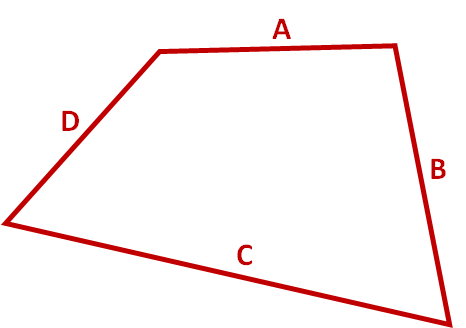The Perimeter of a Quadrilateral calculator computes the semi-perimeter of a quadrilateral based on the length of the four sides. 
INSTRUCTIONS: Choose units and enter the following:
- (A) Length of side A.
- (B) Length of side B.
- (C) Length of side C.
- (D) Length of side D.
Perimeter (p): The calculator returns the semi-perimeter in meters. However, this can be automatically converted to compatible units via the pull-down menu.
The Math / Science
The formula for the perimeter of a quadrilateral is:
`p = a+b+c+d`
where:
- p = quadrilateral perimeters
- a = length of side a
- b= length of side b
- c = length of side c
- d = length of side d
A quadrilateral is a polygon that has four sides, four vertices (corners), and four angles. The sum of the interior angles of any quadrilateral is always 360 degrees. Quadrilaterals can vary widely in shape and properties, including:
- rectangles: squared corners and pairs of equal sides
- squares: squared corners and equal sides
- parallelograms: two sets of parallel sides
- trapezoids: one set of parallel sides
- rhombuses: four equal sides
- kites: two pairs of equal and adjacent sides
Quadrilateral Calculators
- Quadrilateral Area from Sides and Diagonal
- Quadrilateral Area from Sides and Angles
- Quadrilateral Perimeter
- Quadrilateral Semi-Perimeter
- Quadrilateral Volume
- Quadrilateral Weight
- Rectangle Area (A = ω ⋅ h)
- Rectangle Diagonal
- Trapezoid Area: From on top, bottom lengths and separation
- Trapezoid Area from Length of Sides
- Height of a Trapezoid
- Angles of a Trapezoid
- Area of a Kite (or Rhombus)
Regular Polygon Information
A regular polygon is a geometric shape with three or more straight sides where every side is the same length and every angle between connecting sides are the same angle. Because of the symmetry of the regular polygon, all the vertices of the polygon can be constructed to touch a circle in which the regular polygon is inscribed and all the chords that are polygon sides will then obviously be of equal length . Likewise, because of the regular polygon's symmetry, a circle constructed to be inscribed in a regular polygon and touching the polygon will touch the regular polygon at the midpoint of the polygon side. As shown in the pictures, Figure 1 and Figure 2, lines from the regular polygon's vertices to the circle's center form n isosceles triangles of equal area.
Regular Polygon Area Calculators
- Area of Triangle - Three Sides
- Area of a Square - Four Sides
- Area of Pentagon - Five Sides
- Area of Hexagon - Six Sides
- Area of Heptagon - Seven Sides
- Area of Octagon - Eight Sides
- Area of Nonagon - Nine Sides
- Area of Decagon - Ten Sides
- Area of Hendecagon - Eleven Sides
- Area of Dodecagon - Twelve Sides
- Area of Polygon - Any number of sides (n).